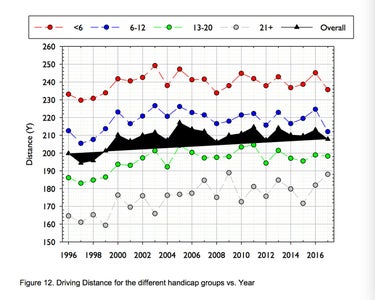A consistent pre-shot routine is a primary key to playing good golf. Here’s a seamless way to incorporate one into your game. The post Simplify your pre-shot routine with these 3 easy steps appeared first on Golf. A consistent pre-shot routine is a primary key to playing good golf. Here’s a seamless way to incorporate…
PGA Tour denounces USGA’s Model Local Rule golf ball, still open to ‘collaborating’

In a memo to players, PGA Tour commissioner Jay Monahan confirmed the Tour won’t support the USGA’s proposed MLR golf ball.
The post PGA Tour denounces USGA’s Model Local Rule golf ball, still open to ‘collaborating’ appeared first on Golf.
In a memo to players, PGA Tour commissioner Jay Monahan confirmed the Tour won’t support the USGA’s proposed MLR golf ball.
The post PGA Tour denounces USGA’s Model Local Rule golf ball, still open to ‘collaborating’ appeared first on Golf.
When the USGA and R&A announced in March that they were looking into changing the golf ball testing protocols and potentially introducing a Model Local Rule golf ball for “elite championships,” professional golfers and equipment manufacturers voiced their concerns. The words “confusing” and “detrimental” were used to describe what golf’s governing bodies were proposing: a glorified ball rollback.
But no matter how much players and manufacturers voiced their displeasure and concern, the general consensus was the MLR would eventually become a reality — even if it meant making significant changes to the ball’s construction to curb distance.
“I think no matter our view, it looks like it’s happening, so it doesn’t really matter what I think or not,” said Jon Rahm during his pre-tournament press conference at the Open Championship. “But if it can be at the forefront of a big company like Callaway who can get ahead of it and that could be invested a little bit earlier, that could be great.
“But yeah, it doesn’t really change. The USGA and the R&A are going to do what they want to do, no matter what I think.”
While it’s true the USGA and R&A can proceed with their proposed testing protocol changes and MLR golf ball, the PGA Tour won’t be embracing the changes — at least not in their current state. In a memo obtained by GOLF.com, Tour commissioner Jay Monahan made it clear that the Tour isn’t on board with the current proposals.
“Although there has been some level of support for limiting future increases, there is widespread and significant belief the proposed Modified Local Rule is not warranted and is not in the best interest of the game,” Monahan said in the memo. “Following a discussion on the topic at a recent PAC meeting, we have notified the USGA and R&A that while the PGA Tour is committed to collaborating with them — and all industry partners — to arrive at a solution that will best serve our players, our fans and the game at all levels, we are not able to support the MLR as proposed.”
The original Area of Interest (AOI) the USGA and R&A rolled out in March 2021 looked at potentially raising the test swing speed for the ODS from 120 mph to at least 125. A follow-up to the original area of interest, introduced in June 2022, proposed studying increased clubhead test speeds “between 125 and 127 mph and will include studies of the effects of these test speeds on the launch conditions and aerodynamics of the golf ball.”
Under the proposed new testing protocols, the governing bodies would test balls in the future at 127 mph clubhead speed with 11 degrees of launch and 2,220 RPMs of spin as the ball setup conditions. For perspective, the current control ball testing setup conditions are 120 mph (plus-or-minus a half mph), 2,520 RPMs (plus-or-minus 120 RPMs) and 10 degrees of launch (plus-or-minus a half degree).
The 127 mph proposed clubhead speed is 12.1 mph faster than the average clubhead speed on the PGA Tour. It also exceeds the average speed for the player with the fastest swing speed on Tour, Brandon Hagy, who currently sits at 126.06 mph. Testing balls at the proposed clubhead speed would mean essentially every ball now being played on Tour would be deemed non-conforming (The Equipment Rules, Part 4, Section 6), as the balls would exceed the 317-yard distance limit set by the governing bodies.
How significant will the difference be? One pro estimated a 300-yard drive might go 280-285 yards with the new ball, although it’s tough to estimate exactly given the number of factors involved.
Under the proposed testing standards, equipment manufacturers would’ve been forced to return to the drawing board to create a new ball to meet the new testing standards.
Shortly after the memo was released, GOLF.com reached out to multiple manufacturers who confirmed they were not aware of the Tour’s decision to denounce the MLR. In the aftermath of the Tour’s response, the USGA responded to a request for comment with the following statement.
“We remain in a Notice & Comment period, accepting feedback from voices from across the game,” said the USGA. “The PGA Tour is an important stakeholder and we appreciate the feedback they have contributed to this conversation.”
While the Tour left the door open to future collaboration, it remains unclear where the USGA and R&A go from here without the Tour’s blessing on the most recent proposal.
It’s important to point out that the MLR was initially slated to go into effect as early as January 2026, so there’s still time for both sides to come back to the table and agree on a suitable future for the ball at the highest level of professional and amateur golf.
Want to overhaul your bag for 2023? Find a fitting location near you at True Spec Golf
The post PGA Tour denounces USGA’s Model Local Rule golf ball, still open to ‘collaborating’ appeared first on Golf.

